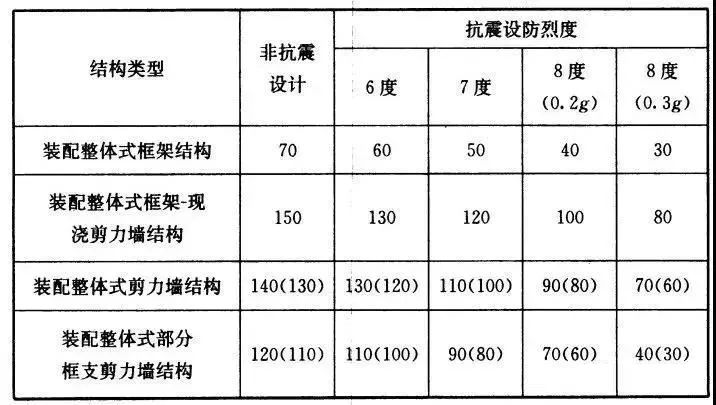Key points and analysis of residential structure design based on precast building
Last year, the total output value of China’s construction industry reached 29.3 trillion yuan, an increase of 11% year-on-year, accounting for 7% of GDP.
Contents and key points of PC special design in each stage scheme stage: PC special design in scheme stage mainly includes the following contents: (1) determine the area proportion and prefabrication rate of precast building according to local policies and owner requirements (2) select precast structure system (3) determine the type and floor range of precast components.
Precast structural system and characteristics full precast shear wall load-bearing system precast shear wall external wall formwork system precast double-sided superimposed shear wall system there are two main factors restricting the precast structural system.
In the process of construction and transformation, these venues have practiced the concept of green and low-carbon development, made full use of intelligent construction and precast technology, well integrated into Chinese traditional cultural elements, and realized the perfect combination of science and technology and humanities, which not only reflects the level of engineering construction in China, but also strongly shows the broad development prospects of intelligent construction and precast buildings.
The scope of precast components in Shanghai only includes the main structure and exterior wall enclosure structure.

Method 1 is only used for concrete structure, and method 2 can be used for concrete structure, steel structure and wood structure.
In the selection of precast floors, the cast-in-situ floor structure should be adopted for the basement floor and roof floor of the house; The cast-in-situ structure shall be adopted for the floor with too large opening..
Among them, when determining the type of precast components, It should be noted that the reinforced area at the bottom of shear wall structure should not be precast, the transfer beam and frame pillar of frame supported structure should be cast-in-situ, and the elevator shaft of high-rise should be cast-in-situ structure.
Prefabrication rate and assembly rate at present, in addition to the unified provisions on the assembly rate in the national standard evaluation standard for precast buildings, Shanghai, Jiangsu, Beijing, Chengdu, Shenzhen, Hunan, Hubei and other provinces and cities have also successively issued detailed rules for the calculation of local prefabrication rate and assembly rate.
The precast house with concrete structure can be calculated by two methods.




The common forms of thermal insulation include sandwich thermal insulation, internal thermal insulation and external thermal insulation.
The National Conference on housing and Urban-Rural Construction held this year made it clear that it will promote the transformation and upgrading of the construction industry and take the development of industrialization, digitization and intelligence as a key work.
The representative processes, advantages and disadvantages of each system are shown in the figure below.

As one of the pillar industries of the national economy, the healthy development of the construction industry will effectively promote economic growth, alleviate employment pressure, promote the construction of new urbanization and ensure and improve people’s livelihood.
1.
The second is the form of building thermal insulation.
At the just concluded Beijing Winter Olympic Games, Winter Olympic venues with a strong sense of science and technology and Chinese style, such as “ice cube”, “ice ribbon”, “snow flying” and “snow Ruyi”, have become a highlight of this winter Olympic Games.
2.


However, there are differences in the scope of components included in the calculation of prefabrication rate (assembly rate) and the conversion proportion of prefabrication rate (assembly rate) of various components.

One is the building height.
The specification lists two calculation methods: calculation method 1: prefabrication rate = volume of precast concrete components / (volume of precast concrete components + volume of cast-in-situ concrete) calculation method 2: prefabrication rate = ∑ (component weight) × correction factor × Precast components (proportion) × The following points should be paid attention to in 100% calculation: 1 The calculation range in Shanghai is above the outdoor floor, and each single building is taken as the calculation unit.
Assembly rate refers to the ratio of the quantity (or area) of precast components and building parts to the total quantity (or area) of similar components or parts in precast buildings.
3.
The common cast structural systems include fully precast shear wall bearing system, precast shear wall exterior wall formwork system, precast double-sided superimposed shear wall system, etc.
According to the provisions of the existing specifications, the assembled integral houses with different structural systems have the maximum applicable height limit.





“Others” refers to the integration of structure and thermal insulation, the integration of wall and window frame, integrated wall, integrated floor and combined reinforced products.
Non concrete precast components such as curtain wall, stone and gypsum board are not included in the prefabrication rate, and the infilled wall of interior wall is not included in the prefabrication rate.
The characteristics of various thermal insulation forms and materials should be considered in the design.

Maximum applicable height of precast integrated structure house (m) common thermal insulation forms and characteristics 3.
Single building assembly rate = single building prefabrication rate + part assembly rate + other part assembly rate = ∑ (part weight) × Proportion of parts) × 100% of which, “part” refers to precast internal partition wall, unit curtain wall, integrated kitchen, integrated toilet, integrated pipe well and integrated smoke exhaust duct.
2.
Taking the calculation rules of prefabrication rate and assembly rate in Shanghai as an example, prefabrication rate refers to the ratio of the material consumption of precast components in the main structure and enclosure structure of precast buildings of concrete structure, steel structure, steel-concrete mixed structure, wood structure and other structural types to the total material consumption of corresponding components.

